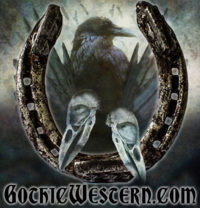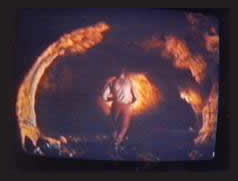“Vengeance” is a Spaghetti Western that definitely qualifies as a great Gothic Western film. Below is a description of the film that is as good as you’re going to get. It is from Evert Jan van Leeuwen’s great post about Gothic Eurowesterns on Brightlightsfilms.com:
In Antony Dawson’s (Antonio Margheriti’s) Vengeance (1968), the relationship between hero and villain is no longer characterized by the moral struggle between good and evil, but takes on the hues of gothic psychological doubling. The gothic double, Manuel Aguirre has explained, “is a figure to flee from, or ignore, or destroy, not one to confront and embrace” because “there is no longer a belief in the possibility of restoring the harmony of human nature” (Aguirre 53). This gothic trope is exemplified in late nineteenth-century gothic tales such as Oscar Wilde’s The Picture of Dorian Gray, in which a young man becomes immortal while his youthful portrait grows monstrous as it comes to represent his corrupt mind. Robert Louis Stevenson’s Dr. Jekyll and Mr. Hyde, in which the doctor loses control of his experiment and ends up killing his degenerate double, is of course the most famous of gothic doubling stories. The hero and villain of Vengeance increasingly come to embody this relationship, where the monster is not an external force to be defeated with masculine muscle or military might, but an aggressive inner demon of the mind that must be confronted and exorcized.
In Vengeance, this doubling works to critique the Hollywood western’s idealization of masculine violence noted by Loy. Joko, the hero cowboy, finds the dismembered body of his friend Richie and swears to get revenge on the bandits who murdered him, making the film a standard revenge western at the outset. However, as Joko gets closer to finding and confronting the bandit Mendoza, the initially orthodox representation of the West increasingly takes on a surreal character. By the finale, Joko, having become as bloodthirsty for revenge as his adversary Mendoza, is lured into a labyrinthine system of dark caves illuminated in lush shades of yellow and orange through which he pursues his enemy.
In this surreal subterranean world, Mendoza’s sinister laugh bounces off the walls as he starts to call out, “I’m over here, here, here . . . Joko, go back . . . you know you can’t kill me!” In response Joko replies: “You’re mad!” as he looks bewilderingly around him and the cavern walls start to spin. There is a clear feeling that these voices are inside Joko’s head. As he pursues the villain deeper into the labyrinth (photo 1), Mendoza, with his face painted white, dressed in a cream-yellow-white suit and trailing a large cape behind him (photo 2) increasingly takes on the form of Joko’s double as he shouts in warning: “get out, get out!” The western setting has now been completely exchanged for a traditionally gothic symbolical underground labyrinth. Both the colour schemes and the traditional western soundtrack recall the cinematography and sounds of Roger Corman’s baroque Poe adaptations for AIP in the 1960s.
Rather than visualizing the underground world an abandoned gold mine, with railway carriages, old beams, and broken pick-axes, Vengeance has the underground passages lead to a central room that looks like a laboratory. Joko’s visage is no longer characterized by the typical macho cowboy gaze oozing his masculine heroic determinism to fight for the good of the community. Instead, his facial contortions show an increasing mental instability. When, after Mendoza’s repeated admonitions, he finally kills the villain, Mendoza’s final words are “you see, you lost, it’s a question of brains, Joko.” The hero’s vengeance is revealed to have served no purpose but to exorcise his own innate aggression, and in the end, Joko literally and willingly gives up his gun. By cutting loose its ties to the American West and focusing on the hero’s psychological struggle with his own violent drives, the movie becomes a gothic allegory of how masculine aggression under western ideological forces has taken monstrous proportions in the form of Mendoza.
You can watch the film below, or check it out HERE.





